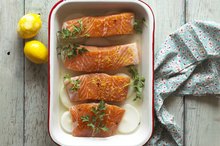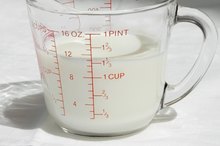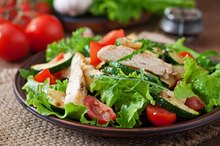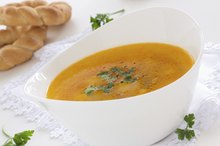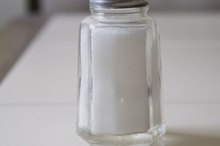Macrobiotic Diet Meal Plan
Unlike early iterations of the diet, macrobiotic meal plans are no longer based solely on a single whole grain, such as brown rice. Current-day macrobiotic diets have a primary focus on whole grains and cereals, followed by fruits and vegetables, and then beans and sea vegetables, often served in the form of soups. In some cases, fish, dairy and meat products are allowed, though sparingly and infrequently.
Whole Grains
Between 40 percent and 60 percent, of your diet, by weight, needs to be made up of whole grains, such as brown rice, millet, wild rice, buckwheat or barley. An easy way to determine proportions is simply to make half your plate whole grains before filling it with any other foods. Limit processed whole-grain products as much as possible, such as pastas and breads -- most of your grains should be eaten on their own. You can boil, steam or braise these grains, although minimal amounts of added fat are recommended. An example of a serving at a meal would be 2 cups of cooked whole grains, served plain.
Fruits and Vegetables
What Is a Typical Daily Norwegian Diet?
Learn More
Between 20 percent and 30 percent of your diet is made up of vegetables and fruits, again measuring by weight. Choose local fruits and vegetables that are in season. Fruits from outside of your growing region, such as tropical fruits if you live in the continental United States, are not recommended. Lightly cooking your vegetables, such as sauteeing or steaming, is best, as this preserves more of the nutrients. Unprocessed fruits and vegetables are suggested, although a small amount of canned and preserved vegetables, such as pickles, is allowed. A serving example of fruits and vegetables would be a 1/3 to 1/2 cup of lightly steamed kale leaves, with no added oil and only a little bit of salt. Two to three times a week, you can include a 1/8-cup serving of fresh blueberries. Serve both fruits and vegetables alongside your 2 cups of whole grains.
Beans, Sea Vegetables and Seasonings
Legumes, including soy products such as miso and tofu, along with sea vegetables, such as wakame, make up 5 percent to 10 percent of your macrobiotic meal plan, again calculating by weight. These foods are commonly served in the form of soups, such as miso soup, flavored only with soy sauce and miso. The Kushi Institute recommends staying mostly with azuki beans, chickpeas and lentils, although tofu, tempeh and natto are also allowed. You can season your soups and other foods with miso, tamari, soy sauce or sea salt. An example of one serving would be a small bowl of miso soup, containing a 3-ounce serving of tofu.
Cooking Methods and Additional Diet Tips
Indian Vegetables & Fruits That Help to Reduce Weight
Learn More
Unprocessed foods are key, and organic food is highly recommended, although not necessary. It is important to fully chew your food, to aid with digestion. Low-fat cooking methods, particularly water-based cooking methods such as braising, steaming or boiling, are recommended for all foods, and a strict macrobiotic diet has food that is cooked only in stainless steel, enamel, wood, glass or ceramic cookware. Caffeine-free teas are allowed on the macrobiotic meal plan, although purified or spring water is the suggested beverage. Limit meat and meat products, including dairy. Fish and seafood are preferable to red meat, poultry or dairy.
Related Articles
References
- American Cancer Society: Macrobiotic Diet
- The Book of Macrobiotics; Micho Kushi
- Kushi Institute: What Is Macrobiotics?
Writer Bio
Jessica Hendricks has worked as a professional journalist for CBS and ABC News in the areas of health, fitness and nutrition. Passionate about wine, she has also worked for several food and drink publications. She holds three master's degrees in Eastern European culture, journalism and nutrition and dietetics.
